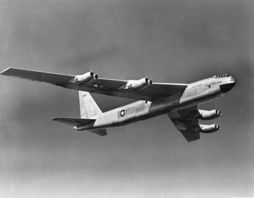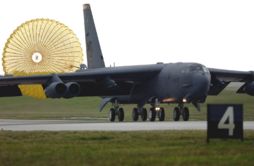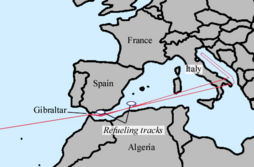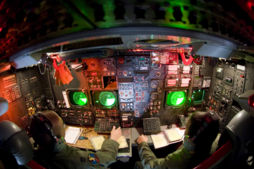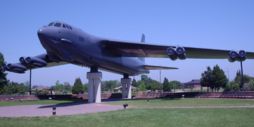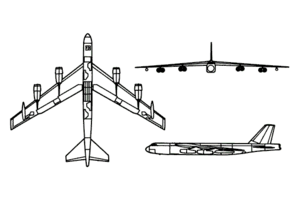PlaneSpottingWorld welcomes all new members! Please gives your ideas at the Terminal.
B-52 Stratofortress
| B-52 Stratofortress | |
|---|---|
| B-52H from 2nd Bomb Wing, Barksdale AFB, LA | |
| Type | Strategic bomber |
| Manufacturer | Boeing |
| Maiden flight | 1952-04-15 |
| Introduced | February 1955 |
| Status | 85 remain in service |
| Primary user | United States Air Force |
| Produced | 1952-1962 |
| Number built | 744 |
| Unit cost | US$14.43 million (B-52B)[1] $9.28 million in 1962 (B-52H) $53.4 million in 1998 (B-52H) |
The Boeing B-52 Stratofortress is a long-range, jetstrategic bomber flown by the United States Air Force (USAF) since 1954.
The B-52 replaced the Convair B-36 and the Boeing B-47. Although built for the role of Cold War-era nuclear deterrent, its conventional capabilities now take priority. The aircraft has the longest range of any bomber and carries a heavy strategic or tactical weapons load.
Its economy in operation and high subsonic performance compared to the rest of the USAF strategic bomber fleet has enabled it to continue to serve rather than be replaced by the Mach 3 XB-70 Valkyrie, B-1B Lancer, and stealth B-2 Spirit. In January 2005, it was the second aircraft after the English Electric Canberra to mark 50 years of continuous service with its original primary customer.
The USAF's Strategic Air Command had B-52 Stratofortresses in active service from 1955 through 1991, when the aircraft were assigned to the Air Combat Command.
Contents
Design and development
On 23 November 1945, Air Materiel Command issued desired performance characteristics for a new strategic bomber. The aircraft was to have a crew of five plus turret gunners, plus a six-man relief crew. It had to cruise at 300 mph (240 knots, 480 km/h) at 34,000 ft (10,365 m) with a combat radius of 5,000 mi (4,340 nm, 8,050 km). The armament was to consist of an unspecified number of 20 mm cannon and 10,000 lb (4,535 kg) of bombs.[1] On 13 February 1946, the Air Force issued bid invitations for these specifications, with Boeing, Consolidated Aircraft, and Glenn L. Martin Company submitting proposals.
On 5 June 1946, Boeing's Model 462, a straight-wing aircraft powered by six Wright T-35 turboprops with a gross weight of 360,000 lb (163,295 kg) and combat radius of 3,110 miles (2,700 nm, 5,010 km), was declared the winner.[1] On 28 June 1946, Boeing was issued a letter of contract for US$1.7 million (1946 dollars, approximately US$17.5 million in 2006) to build a full-scale mockup of the new XB-52 and do some preliminary engineering and testing. However, by October 1946, the Air Force began to express concern about the sheer size of the new aircraft and its inability to meet the specified design requirements. In response, Boeing produced Model 464, a smaller four-engine version with a 230,000 lb (104,325 kg) gross weight, which was briefly deemed acceptable.
Then, in November 1946, Curtis LeMay (who was serving as the Deputy Chief of Air Staff for Research and Development at the time) expressed the desire for a cruise speed of 400 mph (345 knots, 645 km/h), to which Boeing responded with a 300,000 lb (136,080 kg) aircraft.[1] In December 1946, Boeing was asked to change their design to a four-engine bomber with a top speed of 400 mph, range of 12,000 miles (10,430 nm, 19,320 km), and the ability to carry a nuclear weapon. The aircraft could weigh up to 480,000 lb (217,725 kg).[1] Boeing responded with two aircraft, both powered by the T-35 turboprops. The Model 464-16 was a nuclear-only bomber with a 10,000 lb payload, while the Model 464-17 was a general-purpose bomber with a 90,000 lb (40,825 kg) payload.
Due to the cost associated with purchasing two specialized aircraft, the Air Force selected Model 464-17 with the understanding that it could be adapted for nuclear strikes.[1] When the updated requirements were formalized in June 1947, Model 464-17 met all of them except for the range. Furthermore, the entire project hinged on Curtiss-Wright's ability to deliver the T-35 engines.
In the meantime, it was becoming obvious that even with the updated performance, the XB-52 would be obsolete by the time it entered production and would offer little improvement over the Convair B-36. As the result, the entire project was put on hold for six months. During this time, Boeing continued to perfect the design which culminated in Model 464-29 with a top speed of 455 mph (395 knots, 730 km/h) and a 5,000-mile range.[1] In September 1947, the Heavy Bombardment Committee was convened to ascertain performance requirements for a nuclear bomber. Formalized on 8 December 1947, these called for a top speed of 500 mph (435 knots, 805 km/h) and an 8,000-mile (6,955 nm, 12,880 km) range, far beyond the capabilities of 464-29. The crew was reduced to a total of five and defensive armament was to be limited to the tail turret.
The outright cancellation of the Boeing contract in December 1947 was staved off by a plea from its president William McPherson Allen, and in January 1948 Boeing was instructed to thoroughly explore all recent technological innovations, including aerial refueling and the flying wing. Noting stability and control problems Northrop was experiencing with their YB-35 and YB-49 flying wing bombers, Boeing insisted on a conventional aircraft, and in April 1948 presented a US$30 million (1948 dollars, US$250 million in 2006) proposal for design, construction, and testing of two Model 464-35 prototypes. Further revisions of specifications during 1948 resulted in an aircraft with a top speed of 513 mph (445 knots, 825 km/h) at 35,000 ft (10,670 m), range of 6,909 mi (6,005 nm, 11,125 km), and a 280,000 lb (127,000 kg) gross weight which included 10,000 lb of bombs and 19,875 US gal (75,225 l) of fuel.[1]
The advent of more fuel-efficient jet engines resulted in Boeing developing yet another revision — in July 1948, Model 464-40 substituted Westinghouse J40 turbojets for the turboprops. Nevertheless, on 21 October 1948, Boeing was told to create an entirely new airplane with Pratt & Whitney J57 turbojets. Remarkably, on 25 October, Boeing engineers produced a proposal as well as a hand-carved model of 464-49. The new design built upon the basic layout of the B-47 Stratojet with 35-degree swept wings, eight engines paired in four underwing pods, and bicycle landing gear with wingtip outrigger wheels. The aircraft was projected to exceed all design specifications.[1] Although the full-size mockup inspection in April 1949 was generally favorable, range again became a concern since both the J40s and the early-model J57s had excessive fuel consumption.
Despite some talk of another revision of specifications or even a full-out design competition among aircraft manufacturers, General LeMay, who by that time was in charge of Strategic Air Command, insisted that performance should not be compromised due to delays in engine development.[1] In a final attempt to increase the range, Boeing created the larger 464-67, stating that once in production, the range could be further increased in subsequent modifications. Following several direct interventions by LeMay, on 14 February 1951, Boeing was awarded a production contract for 13 B-52As and 17 detachable reconnaissance pods. This was shortly followed by orders for four more B-52s and 43 reconnaissance RB-52s. The last major change in the design, also at the insistence of General LeMay, was a switch from B-47-like tandem seating to a more conventional side-by-side cockpit which increased the effectiveness of the co-pilot and reduced crew fatigue.[1]
The YB-52 (actually, the second XB-52 with more operational equipment) first flew on 15 April 1952. The flight was largely uneventful. The XB-52 followed on 2 October 1952. The thorough development, including 670 days in the wind tunnel and 130 days of aerodynamic and aeroelastic testing paid off with smooth flight testing. Encouraged, the Air Force increased its order to 282 B-52s.[1]
The first production B-52A differed from prototypes in having a 21-inch (53 cm) nose extension to accommodate more avionics, a tail turret with four 0.50 in (12.7 mm) machine guns, and a water injection system to augment engine power with a 360 US gal (1,363 l) water tank in the rear fuselage. The aircraft also carried a pair of 1,000 US gal (3,785 l) external fuel tanks under the wings. At the rollout ceremony on 18 March 1954, General Twining said "The long rifle was the great weapon of its day. ... Today this B-52 is the long rifle of the air age."[1]
Operational history
Although the B-52A was the first production variant, the aircraft were used only in testing. The first operational version was the B-52B which had been in development in parallel with the prototypes since 1951, first flying in December 1954. The B-52B number 52-8711 entered operational service with 93rd Heavy Bombardment Wing at Castle Air Force Base, California, on 29 June 1955. The wing became operational on 12 March 1956. The training for B-52 crews consisted of five weeks of ground school and four weeks of flying, accumulating 35-50 hours in the air.[1] The new B-52Bs replaced operational B-36s on a 1-to-1 basis.
Early operations were complicated by lack of spares and ground facilities while ramps and taxiways deteriorated under the weight of the aircraft. The fuel system was prone to leaks and icing, and bombing and fire control computers were unreliable. The two-story cockpit presented a unique climate-control problem – the pilots' cockpit was heated by sunlight while the observer and the navigator on the bottom deck sat on the ice-cold floor. Thus, comfortable temperature setting for the pilots caused the other crew members to freeze, while comfortable temperature for the bottom crew caused the pilots to overheat. The J57 engines were still new and unreliable. Alternator failure caused the first fatal B-52 crash in February 1956, which resulted in a brief grounding of the fleet. B-52s were grounded again in July because of fuel and hydraulic system problems. To avoid maintenance problems, the Air Force set up Sky Speed teams of 50 maintenance contractors at each B-52 base. In addition to maintenance, the teams performed routine checkups which took one week per airplane.[1]
Vietnam war
With the escalating situation in Southeast Asia, in June 1964 twenty-eight B-52Fs were fitted with external racks for 24x 750 lb (340 kg) bombs under project South Bay. An additional 46 aircraft received similar modifications under project Sun Bath. In March 1965, the United States commenced Operation Rolling Thunder, and the first combat mission of (Operation Arc Light-B-52 missions) was flown by B-52Fs on 18 June 1965, when thirty bombers from the 9th and 441st Bombardment Squadrons struck a communist stronghold near Ben Cat in South Vietnam. The first wave of bombers arrived too early at a designated rendezvous point, and while maneuvering to maintain station, two B-52's collided, resulting in the loss of two bombers and eight crewmen. The remaining bombers, minus one more which turned back due to mechanical problems, continued on towards the target, which was bombed successfully.
In December 1965, a number of B-52Ds underwent Big Belly modifications to increase bomb capacity for carpet bombings. While the external payload remained at 24x 500 lb (227 kg) or 750 lb (340 kg) bombs, the internal capacity increased from 27 to 84x 500 lb bombs or from 27 to 42x 750 lb bombs. Thus modified, B-52Ds could carry 22,000 lb (9,980 kg) more than B-52Fs.[1] Replacing B-52Fs, modified B-52Ds entered combat in April 1966 flying from Guam. In the spring of 1967, the aircraft began flying from Thailand which had the advantage of not requiring in-flight refueling. On 15 April 1968, a Replacement Training Unit was established at Castle AFB which converted B-52E through B-52H crews to B-52Ds so they could partake in combat in Southeast Asia. The zenith of B-52 attacks in Vietnam was Operation Linebacker II which consisted of waves of B-52s (mostly D models, but some Gs without jamming equipment and with a smaller bomb load) bombing Hanoi.
Thirty-one B-52s were lost in Vietnam .[2] Of these, 18 were shot down by ground fire or damaged beyond repair, including surface-to-air missiles. Two B-52Fs were lost in a mid-air collision during the first Arc Light mission. Seven B-52Gs were lost during Linebacker II, six to SAMs and one to structural failure.[1] B-52D tail gunners were credited with shooting down two MiG-21 'Fishbeds'; one on December 18, 1972, by SSgt Samuel O. Turner, and one on December 24, 1972, by A1C Albert E. Moore. Turner was awarded a Silver Star for his actions.[3]
Cold war
During the Cold War, B-52s performed airborne alert duty under the codename Chrome Dome. Bombers loitered near points outside the Soviet Union to provide rapid first-strike or retaliation capability in case of nuclear war.[4]
On 17 January 1966, a fatal collision occurred between a B-52G and a KC-135 Stratotanker over Palomares, Spain. Four megaton-range nuclear bombs fell into the sea (all four were eventually recovered). Two of the four bombs had a minor detonation, as the warheads' conventional explosives were set off, with serious dispersion of both plutonium and uranium. The main fuse safety withstood the violent impact and explosion, preventing a nuclear disaster. After the crash, 1,400 tons of contaminated soil were sent to the United States.[1] The crash and the decontamination were too expensive to risk again and ended the airborne alert program. In 2006 an agreement to investigate and clean the pollution after the accident was made between the U.S. and Spain.[citation needed]
On 22 January 1968, another B-52G with four nuclear bombs aboard crashed on the ice of the North Star Bay while attempting an emergency landing at Thule Air Base in Greenland. The resulting fire caused extensive radioactive contamination the cleanup of which lasted until September.[1]
The Yom Kippur War in October 1973 saw the Soviet Union threaten to intervene on behalf of Egypt and Syria. To stop the Soviets, President Richard M. Nixon called on the military to raise its alert level to DEFCON 3. Secretary of Defense Melvin Laird ordered the B-52s to an immediate war footing. Fully armed and fueled B-52s were circling Greenland. The Soviet Union did not become directly involved in the war.
B-52Bs reached the end of structural service life by mid-1960s and all were retired by June 1966, followed by the last of the B-52Cs on 29 September 1971. A few time-expired E models were retired in 1967 and 1968, but the bulk (82) were retired between May 1969 and March 1970. Most F models were also retired between 1967 and 1973, but 23 survived as trainers until late 1978.
The fleet of D models served much longer. Eighty D models were updated under the Pacer Plank program (ECP 1581) at Boeing's Wichita plant. Skinning on the lower wing and fuselage was replaced, and various structural components were renewed. Work was completed in 1977 at a cost of $219 million. The fleet of D models stayed largely intact until late 1978, when 37 were retired. The remainder were retired between 1982 and 1983.
The remaining G and H models were used for nuclear standby ("alert") duty as part of the United States' nuclear triad. This triad was the combination of nuclear-armed land-based missiles, submarine-based missiles and manned bombers. The B-1B Lancer which was intended to supplant the B-52, replaced only the older models and the supersonic FB-111. The B-2 Spirit also accelerated the retirement of the B-52G models but did not lead to complete retirement either.[citation needed]
After the fall of the Soviet Union, the B-52Gs were destroyed per the terms of the Strategic Arms Reduction Treaty (START). Today only the H models remain in service.[citation needed] In 1991, President George H.W. Bush took the B-52s off alert duty.[citation needed]
Gulf war and later
- See also: Gulf War
High-altitude carpet-bombing by B-52s was an important part of the air war during Operation Desert Storm in 1991 (Iraq/Southwest Asia). Since the Coalition forces had complete air superiority and were able to suppress any air defense systems capable of reaching the high-altitude bombers, they could be employed with impunity. Though less destructive than more advanced weapons such as cluster-bombs or precision guided projectiles, the conventional strikes were used because they were economical, and it was hoped that by demoralizing the defending Iraqi troops, they could be induced to surrender rather than be destroyed.[citation needed]
The B-52 also contributed to the U.S. success in Operation Enduring Freedom in 2001 (Afghanistan/Southwest Asia), providing the ability to loiter high above the battlefield and provide Close Air Support (CAS) through the use of precision guided munitions, a mission that had been restricted to fighter and ground attack aircraft. B-52s also played a key role in Operation Iraqi Freedom, which commenced in 2003 (Iraq/Southwest Asia), where they provided close air support and bombing.[citation needed]
In-service modifications
In November 1959, SAC initiated the Big Four modification program (also known as Modification 1000) for all operational B-52s except early B models. The four modifications were:
- Ability to perform all-weather low-altitude (below 500 ft {150 m}) interdiction as a response to advancements in Soviet Union's missile defenses. The low-altitude flights were estimated to accelerate structural fatigue by at least a factor of eight, requiring costly repairs to extend service life.
- Ability to launch AGM-28 Hound Dog standoff nuclear missiles
- Ability to launch ADM-20 Quail decoys
- An advanced electronic countermeasures (ECM) suite
The program was completed by 1963 at a cost of US$265 million.[1]
The ability to carry up to 20 AGM-69 SRAM nuclear missiles was added to G and H models starting in 1971 a cost of US$400 million.[1]
Fuel leaks due to deteriorating Marman clamps continued to plague all variants of the B-52. To this end, the aircraft were subjected to Blue Band (1957), Hard Shell (1958), and finally QuickClip (1958) programs. The latter fitted safety straps which prevented catastrophic loss of fuel in case of clamp failure.[1]
Ongoing problems with advanced avionics were addressed in the Jolly Well program, completed in 1964, which improved components of the AN/ASQ-38 bombing-navigational computer and the terrain computer. The MADREC (Malfunction Detection and Recording) upgrade fitted to most aircraft by 1965 could detect failures in avionics and weapons computer systems, and was essential in monitoring the Hound Dog missiles. The electronic countermeasures capability of the B-52 was expanded with Rivet Rambler (1971) and Rivet Ace (1973).[1]
Structural fatigue, exacerbated by the change to low-altitude missions, was first dealt with in the early 1960s by the three-phase High Stress program which enrolled aircraft at 2,000 flying hours. This was followed by a 2,000-hour service life extension to select airframes in 1966-1968, and the extensive Pacer Plank reskinning completed in 1977.[1] The wet wing introduced on G and H models was even more susceptible to fatigue due to experiencing 60% more stress during flight than the old wing. The wings were modified by 1964 under ECP 1050 at a cost of US$219 million. This was followed by a US$50 million fuselage skin and longeron replacement (ECP 1185) in 1966, and the US$69 million B-52 Stability Augmentation and Flight Control program (ECP 1195) in 1967.[1]
Fuel research platform
In September 2006, the B-52 became one of the first US military aircraft to fly using 'alternative' fuel. Syntroleum, a leader in Fischer-Tropsch (FT) technology, announced that its ultra-clean jet fuel had been successfully tested in a B-52. It took off from Edwards Air Force Base with a 50/50 blend of FT and traditional JP-8 jet fuel which was burned in two of the eight engines on the plane. This marked the first time that FT jet fuel has been tested in a military flight demo, and is the first of several planned test flights.[5]
On December 15, 2006, tail number 61-0034, Wise Guy took off from Edwards with the synthetic fuel blend powering all eight engines, the first time an Air Force aircraft has been completely powered by the mixture. The test flight was captained by Major General Curtis Bedke, commander of the Edwards Flight Test Center, the first time in 36 years that the installation's commander has performed a first-flight in a flight test program. The flight lasted seven hours, reached an altitude of 48,000 feet, and was considered a success.[5]
This program is part of the Department of Defense Assured Fuel Initiative, an effort to develop secure domestic sources for the military energy needs. The Pentagon hopes to reduce its use of crude oil and foreign producers and obtain about half of its aviation fuel from alternative sources by 2016.[5]
Future of the B-52
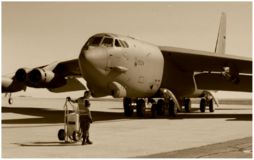
The Air Force intends to keep the B-52 in service until at least 2040, an unprecedented length of service for a military aircraft.[6] This is especially remarkable considering the last B-52 was built in 1962. B-52s are periodically rebuilt at the USAF maintenance depots such as Tinker Air Force Base, Oklahoma. Therefore, despite their chronological age, their effective service age is quite young.[citation needed]
Boeing has suggested re-engining the B-52H fleet with the Rolls-Royce RB211 534E-4. This would involve replacing the eight Pratt & Whitney TF33s (total thrust 8 x 17,000 lbf or 30.574 kN) with four RB211s (total thrust 4 x 37,400 lbf or 33.191 kN). The RR engines will increase the range and payload of the fleet and reduce fuel consumption. However, the cost of the project would be significant. Procurement would cost approximately US$2.56 billion (US$36 million × 71 aircraft). A General Accounting Office study of the proposal concluded that Boeing's estimated savings of US$4.7 billion would not be realized. They found that it would cost the Air Force US$1.3 billion over keeping the existing engines. [7]
The USAF continues to employ the B-52 because it remains an effective economical heavy bomber, particularly for the type of conflicts conducted since the end of the Cold War against nations with limited air defense capabilities. The B-52's capacity to linger for long times over battlefields delivering precision standoff and direct fire munitions has been a valuable asset in conflicts such as Operation Enduring Freedom in Afghanistan.
The stealth and speed of the B-1 Lancer and B-2 Spirit have only been useful until enemy air defenses were destroyed, a task that has been swiftly achieved in recent conflicts. The B-52 boasts the highest mission-capable rate of the three types of heavy bombers operated by the USAF. Whereas the B-1 averages a 57% ready rate [8] and the B-2 achieved a 26% in 1997 [9], the B-52 averages 80%.[citation needed]
Notable achievements
- On 21 May 1956, B-52B dropped its first live nuclear bomb over the Bikini Atoll.
- On 24-25 November 1956, eight B-52Bs flew non-stop around the perimeter of North America in Operation Quick Kick, covering 15,530 miles (13,500 nm, 25,000 km) in 31 hours 30 minutes. The SAC noted that the flight time could have been reduced by 5-6 hours if the four in-flight refuelings were done by fast jet-powered tanker aircraft rather than propeller-driven KC-97 Stratotankers.
- On 16-18 January 1957, three B-52Bs made a non-stop flight around the world during Operation Power Flite, covering 24,325 miles (21,145 nm, 39,165 km) in 45 hours 19 minutes with several in-flight refuelings by KC-97s. The 93rd Bomb Wing received the Mackay Trophy for their accomplishment.
- On 26 September 1958, a B-52D set a world speed record of 560.705 mph (645 knots, 1,038 km/h) over a 10,000 km (5,400 nm, 6,210 mi) closed circuit without a payload. The same day, another B-52D established a world speed record of 597.675 mph (688 knots, 1,107 km/h) over a 5,000 km (2,700 nm, 3,105 mi) closed circuit without a payload.
- On 14 December 1960, a B-52G set a world record by flying unrefueled for 10,078.84 miles (8,762 nm, 16,227 km). The flight lasted 19 hours 44 minutes.
- On 10-11 January 1962, a B-52H set a world record by flying unrefueled from Kadena Air Base, Okinawa, Japan, to Torrejon Air Base, Spain, covering 12,532.28 miles (10,895 nm, 20,177 km).[1]
- In 1991 a flight of B-52Gs launching from and returning to Barksdale AFB struck targest inside of Iraq. This was at the time the longest distance combat mission in history: 35 hours and 14,000 miles round trip.
- On 2-3 September 1996, two B-52H struck Iraqi targets with 13 conventional air-launched cruise missiles as part of Operation Desert Strike, a 34-hour, 16,000-mile round-trip mission from Andersen AFB. The flight was the longest distance ever flown for a combat mission. Only two days prior, the crews had completed a 17-hour flight from Louisiana just to reach Guam.
Costs
The costs are in approximate 1955 United States dollars and have not been adjusted for inflation.[1]
| X/YB-52 | B-52A | B-52B | B-52C | B-52D | B-52E | B-52F | B-52G | B-52H | |
|---|---|---|---|---|---|---|---|---|---|
| Unit R&D cost | 100 million | ||||||||
| Airframe | 26,433,518 | 11,328,398 | 5,359,017 | 4,654,494 | 3,700,750 | 3,772,247 | 5,351,819 | 6,076,157 | |
| Engines | 2,848,120 | 2,547,472 | 1,513,220 | 1,291,415 | 1,256,516 | 1,787,191 | 1,427,611 | 1,640,373 | |
| Electronics | 50,761 | 61,198 | 71,397 | 68,613 | 54,933 | 60,111 | 66,374 | 61,020 | |
| Armament | 47,874 | 482,284 | 293,346 | 548,353 | 931,665 | 862,839 | 840,000 | 1,501,422 | |
| Ordnance | 9,193 | 11,520 | 10,983 | 17,928 | 4,626 | 3,016 | 6,809 | 6,804 | |
| Flyaway cost | 28.38 million | 14.43 million | 7.24 million | 6.58 million | 5.94 million | 6.48 million | 7.69 million | 9.28 million | |
| Maintenance cost per flying hour | 925 | 1,025 | 1,025 | 1,182 |
Variants[1]
- B-52A
- First production version, 3 built, all loaned to Boeing for flight testing.
- NB-52A
- The last B-52A (serial 52-0003) was modified in 1959 to carry the North American X-15 at a cost of US$2 million. A pylon was fitted under the right wing between the fuselage and the inboard engines with 6 ft x 8 ft (1.8 x 2.4 m) section was removed from the right wing flap to fit the X-15 tail. Liquid oxygen tanks were installed in the bomb bays to refuel the X-15 before launch. First flight with X-15 was on 10 March 1959, and NB-52A carried the X-15 on 59 of the program's 199 flights.
- B-52B
- Upgraded engines and avionics. Of the 50 built, 27 were capable of carrying a reconnaissance pod as RB-52Bs (the crew was increased to eight in these aircraft). Seven B-52Bs were brought to B-52C standard under Project Sunflower.
- RB-52B
- B-52B bombers capable of carrying the reconnaissance pod. The 300 lb (136 kg) pod contained radio receivers, a combination of K-36, K-38 and T-11 cameras, and two operators on downward-firing ejection seats. The pod required only four hours to install.
- NB-52B
- B-52B number 52-0008 converted to an X-15 launch platform at a cost of US$2 million. It subsequently flew as the famous "Balls 8" in support of NASA research until 17 December 2004, making it the oldest flying B-52B. It was replaced by a modified B-52H.
- B-52C
- Gross weight increased by 30,000 lb (13,605 kg), increased fuel capacity, larger underwing fuel tanks, antiflash white paint. Entered service in June 1956, 35 were built.
- RB-52C
- Any B-52C could be converted for reconnaissance duties in a similar manner to RB-52Bs
- B-52D
- Dedicated long-range bomber without a reconnaissance option, entered service in December 1956, 170 built. Modified to carry heavy loads of conventional bombs for carpet bombing over Vietnam. Bottoms painted black to defeat searchlights.
- B-52E
- Updated avionics and bombing-navigational system, entered service in December 1957, 100 built.
- NB-52E
- One aircraft (number 56-0632) modified as a testbed for various B-52 systems at a cost of US$6.02 million. The aircraft was fitted with canards and a Load Alleviation and Mode Stabilization system (LAMS) which reduced airframe fatigue from wind gusts during low level flight. In one test, the aircraft flew 10 knots (11.5 mph, 18.5 km/h) faster than the do not exceed speed without any damage because the canards eliminated 30% of vertical and 50% of horizontal vibrations caused by wind gusts.
- B-52F
- J57-P-43W engines with a larger-capacity water injection system and new alternators, entered service in June 1958, 89 built.
- B-52G
- The B-52G was proposed to extend the B-52 service life during delays in the B-58 Hustler program. At first, a radical redesign was envisioned with a completely new wing and Pratt & Whitney J75 engines. This was rejected to avoid slowdowns in production, although some changes were implemented. The most significant of these was the brand-new "wet" wing with integral fuel tanks which considerably increased the fuel capacity — gross aircraft weight went up by 38,000 lb (17,235 kg) compared with prior variants. In addition, a pair of 700 US gal (2,650 l) external fuel tanks was fitted under the wings. The wing also had the traditional ailerons eliminated, instead utilizing spoilers for roll control. The tail fin was shortened by 8 ft (2.4 m), water injection system capacity was increased to 12,000 US gal (45,420 l), and the nose radome was enlarged. The tail gunner was provided with an ejection seat and moved to the main cockpit. Dubbed the "battle-station" concept, the offensive crew (pilot, co-pilot, and the two bombing-navigation system operators on the lower deck) faced forward, while the defensive crew (gunner and ECM operator) on the upper deck faced aft. The B-52G entered service 13 February 1959 (a day earlier, the last B-36 was retired, making SAC an all-jet bomber force), 193 produced. All B-52Gs were destroyed in compliance with the START I treaty.
- B-52H
- The same crew and structural changes as the B-52G. The most significant upgrade was the switch to TF33-P-3 turbofan engines which, despite the initial reliability problems (corrected by 1964 under the Hot Fan program), offered considerably better performance than the venerable J57 turbojets. The ECM and avionics were updated, a new fire-control system was fitted, and the rear defensive armament was changed from machine guns to a 20 mm M61 Vulcan cannon. A provision was made for four AGM-48 Skybolt ballistic missiles. First flight 10 July 1960, entered service 9 May 1961, 102 aircraft built. The only variant that is still operational.
A total of 744 B-52s were built. The last production aircraft, a B-52H number 61-0040, left the factory on 26 October 1962.
USAF Stations
Template:Main article The B-52 is stationed at two USAF bases
Specifications (B-52H)
Data from Quest for Performance[10] and [1]
General characteristics
- Crew: 5 — pilot, co-pilot, radar navigator (bombardier), navigator, and Electronic Warfare Officer; gunners are no longer a part of the crew.
- Length: 159 ft 4 in (48.5 m)
- Wingspan: 185 ft 0 in (56.4 m)
- Height: 40 ft 8 in (12.4 m)
- Wing area: 4,000 ft² (370 m²)
- Airfoil: NACA 63A219.3 mod root, NACA 65A209.5 tip
- Empty weight: 185,000 lb (83,250 kg)
- Loaded weight: 265,000 lb (120,000 kg)
- Max takeoff weight: 488,000 lb (220,000 kg)
- Fuel capacity: 47,975 US gal (181,725 L)
- Powerplant: 8× Pratt & Whitney TF33-P-3/103 turbofans, 17,000 lbf (76 kN) each
- * Zero-lift drag coefficient: 0.0119 (estimated)
- Drag area: 47.60 ft² (4.42 m²)
- Aspect ratio: 8.56
Performance
- Maximum speed: 560 knots (650 mph, 1,000 km/h)
- Combat radius: 4,480 mi (3,890 nm, 7,210 km)
- Ferry range: 11,000 mi (8,099 nm, 15,000 km)
- Service ceiling: 55,773 ft (17,000 m)
- Rate of climb: 6270 ft/min[11] (31.85 m/s)
- Wing loading: 30 lb/ft² (150 kg/m²)
- Thrust/weight: 0.51
- Lift-to-drag ratio: 21.5 (estimated)
Armament
Gallery
As part of Operation Allied Force, B-52H Stratofortresses take off from RAF Fairford, United Kingdom, to strike targets in the Federal Republic of Yugoslavia.
References
- ↑ 1.00 1.01 1.02 1.03 1.04 1.05 1.06 1.07 1.08 1.09 1.10 1.11 1.12 1.13 1.14 1.15 1.16 1.17 1.18 1.19 1.20 1.21 1.22 1.23 1.24 1.25 1.26 1.27 1.28 Knaack, Marcelle Size (1988). Post-World War II bombers, 1945-1973. Office of Air Force History. ISBN 0-16-002260-6.
- ↑ Vietnam war combat loss record
- ↑ Futrell 1976
- ↑ This article incorporates text from http://www.nationalmuseum.af.mil/factsheets/factsheet.asp?id=1851, a public domain work of the United States Government. [1]
- ↑ 5.0 5.1 5.2 Zamorano, Marti, "B-52 synthetic fuel testing: Center commander pilots first Air Force B-52 flight using solely synthetic fuel blend in all eight engines", Aerotech News and Review, 2006-12-22
- ↑ B-52 Stratofortress. U.S. Air Force. Retrieved on 2007-02-08.
- ↑ [2]
- ↑ [3]
- ↑ [4]
- ↑ Loftin, LK, Jr.. Quest for performance: The evolution of modern aircraft. NASA SP-468. Retrieved on 2006-04-22.
- ↑ Baugher, Joe. Boeing B-52 Stratofortress - Chapter 22. Retrieved on 2006-11-03.
- Futrell RF, Greenhalgh WH, Grubb C, Hasselwander GE, Jakob RF, and Ravenstein CA (1976). The United States Air Force in Southeast Asia - Aces and aerial victories, 1965-1973. Office of Air Force History. ISBN 0-8987-5884-X.
- Michel L. Marshall III,"The Eleven Days of Christmas: America's Last Vietnam Battle", Encounter Books, San Francisco, 2002.
- Hobson, Chris-"Vietnam Air Losses." 2001, ISBN 1 85780 1156
External links
- Tribute to the B-52 at YouTube.com
- Weapons of Mass Destruction (WMD) B-52 Stratofortress
- U.S. Force B-52 Stratofortress Fact Sheet
- NASA Dryden B-52 fact sheet
- A detailed historical overview of the B-52
- Aerospaceweb.org profile of the B-52
- Analysis of Fairchild AFB crash
- http://www.nampows.org/B-52.html 25 B-52 lost in Vietnam
Related content
Related development
Comparable aircraft
Designation sequence
- Air Force: YB-49 - B-50 - XB-51 - B-52 - XB-53 - B-54 - XB-55
- Boeing: 345 - 367 - 377 - 464 - 701 - 707 - 717
Related lists
Template:Active military aircraft of the United States
See also
Lists relating to aviation | |
|---|---|
| General | Timeline of aviation · Aircraft · Aircraft manufacturers · Aircraft engines · Aircraft engine manufacturers · Airports · Airlines |
| Military | Air forces · Aircraft weapons · Missiles · Unmanned aerial vehicles (UAVs) · Experimental aircraft |
| Notable incidents and accidents | Military aviation · Airliners · General aviation · Famous aviation-related deaths |
| Records | Flight airspeed record · Flight distance record · Flight altitude record · Flight endurance record · Most produced aircraft |
als:B-52 ar:بي 52 cs:B-52 Stratofortress da:B-52 Stratofortress de:Boeing B-52 es:B-52 Stratofortress fr:Boeing B-52 Stratofortress gl:B-52 Stratofortress it:Boeing B-52 Stratofortress he:B-52 סטרטופורטרס hu:B–52 Stratofortress ms:B-52 Stratofortress nl:B-52 Stratofortress ja:B-52 (爆撃機) no:Boeing B-52 Stratofortress pl:Boeing B-52 Stratofortress pt:B-52 Stratofortress ru:B-52 Stratofortress simple:B-52 Stratofortress sk:Boeing B-52 Stratofortress fi:B-52 Stratofortress sv:Boeing B-52 Stratofortress vi:B-52 tr:B-52 zh:B-52同溫層堡壘轟炸機 th:บี-52 สตราโตฟอสเตรส
